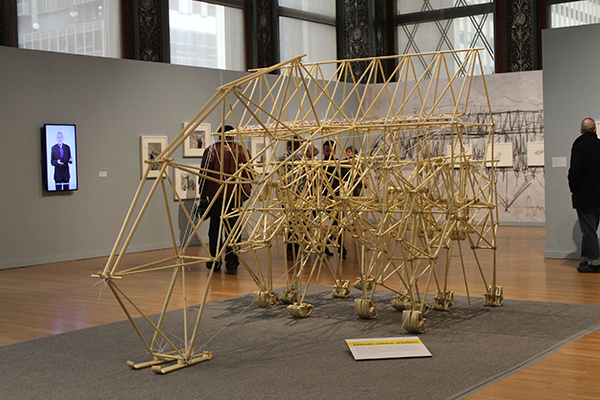By Katina Beniaris
Video By Qingwei Vivian Chen
Inside the Chicago Cultural Center’s newest exhibit, the Strandbeest comes alive with its bone-yellow pipes hitting the floor as it walks toward the visitors. Dutch artist Theo Jansen, the creator of Strandbeests, describes these new life-forms as “beach creatures.”
“Hopefully in 20 years, mark my words, these animals will live on beaches,” Jansen said after demonstrating the moving art sculptures Feb. 7 at the Chicago Cultural Center (78 E. Washington St.).
“Strandbeest: The Dream Machines of Theo Jansen with Photography by Lena Herzog” runs through May 1 at the Cultural Center’s fourth floor. Organized by the Peabody Essex Museum in Salem, Massachusetts, this exhibition is the first United States tour of the Strandbeests. The Chicago exhibit opened Feb. 5 and it gives a close, interactive look at the Strandbeests’ creation process.
[vimeo 159103298 w=500 h=281]
“The great thing about this exhibit is that [the ‘beests’] move. They’re not just meant to stand as fossils,” said Hayley Barron, a public relations and communications intern at the Chicago Cultural Center.
Over the past 25 years, Jansen has combined art and science to guide the Strandbeests evolution. Over 40 “generations” of Strandbeests constructed with PVC pipes come in different shapes and sizes, all based on a genetic algorithm. A YouTube video of the Strandbeest’s evolution posted in 2013 has received over 1.3 million views, which helped put his creatures in the middle of a universal conversation.
At the start of the evolutionary process, Jansen created 13 “holy numbers” on an Atari home computer. He recently shared this algorithm with artists all over the world, allowing them to create their own Strandbeests.
“Since then, thousands of students in the whole world are making Strandbeests using this [DNA] code,” Jansen said. “All these students think they are having a good time… But the fact is that they are used for the reproduction.”

The exhibit displays some of these reproduced Strandbeests, along with other beests originally created by Jansen. Visitors are most attracted to the activities displaying the creatures’ unique locomotion. Hired by the Peabody Essex Museum, a group of “beest wranglers” run the daily demonstrations found at the end of the exhibit.
“Guests must enter the exhibit through the entrance so you can learn about how [Theo Jansen’s art] is made,” Barron said. “Although everyone wants to see the daily demonstrations, it’s important to know how these things work. All the ideas are put together and put to life literally when the beest comes to life and walks towards you.”
The Chicago exhibit has drawn engineers, families, school groups and tourists to see the Strandbeests live in action. According to numbers provided by the Chicago Department of Cultural Affairs and Special Events, the Chicago exhibit drew over 10,000 visitors during its opening weekend in February.

The department has also provided interactive public programs centered on the exhibit including a sold-out March 18 event ,“Up All Night with the ‘Beests’ Family Overnight,” which gives families a special sleepover experience to learn more about the Strandbeests.
“I did background research about Theo Jansen, and I really liked the concept of creating autonomous life-forms out of organic materials,” said Christian McLain, a Columbia College Chicago student who works as a beest wrangler. “I find it was super-interesting to have a job that was more interactive with people and with the beests themselves.”
The Strandbeest exhibit is free. For more information about the daily demonstrations schedule and exhibit hours, visit www.chicagoculturalcenter.org.


